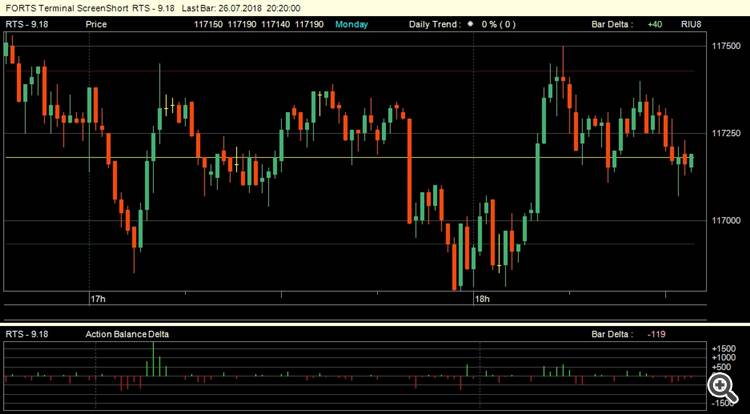Discussão do artigo "Escrita de indicadores de bolsa com controle de volume usando o indicador delta como exemplo"
Parabéns, Alexei!
Seu indicador está funcionando corretamente)
Fico feliz em ouvir isso! Essa era a ideia:)
Parabéns, Alexei!
Seu indicador está funcionando corretamente)
Como você conseguiu verificá-lo?
Como você verificou?
Por comparação visual.
Como você conseguiu verificar?
Você mesmo pode verificar! Basta fazer o download do indicador e dar uma olhada. O volume total no candlestick deve ser igual à soma dos volumes de compra e venda. Você pode comparar os volumes abrindo a janela de dados do terminal "ctrl+d".
Não entendi muitas coisas do artigo, especialmente como um novo tick pode aparecer, mas não haverá uma nova barra? Ou seja, uma nova barra é formada estritamente após o aparecimento de um tique (não em paralelo), ou esse processo é completamente assíncrono? Com que frequência essa situação ocorre? É geralmente aceito verificar o aparecimento de uma nova barra, se a negociação for feita na abertura da barra, e aqui acontece que esse método frequentemente (sempre?) fica defasado?
Não entendi muitas coisas do artigo, especialmente como um novo tick pode aparecer, mas não haverá uma nova barra? Ou seja, uma nova barra é formada estritamente após o aparecimento de um tique (não em paralelo), ou esse processo é completamente assíncrono? Com que frequência essa situação ocorre? É geralmente aceito verificar o surgimento de uma nova barra, se a negociação for feita na abertura da barra, e aqui acontece que esse método frequentemente (sempre?) fica defasado?
Essa situação pode ocorrer com bastante frequência. Novamente, baixe o indicador, ative o registro e procure as seguintes linhas no registro do terminal:
if(inpLog) Print(__FUNCTION__,"O tique do futuro ["+GetMsToStringTime(_ticks.GetTickTimeMs(i))+"]. Tempo de tique-taque "+TimeToString(_ticks.GetTickTime(i))+ ", time[ rates_total-1 ]+PerSec() = "+TimeToString(time[rates_total-1]+PeriodSeconds()));
Em relação à verificação do aparecimento de uma nova barra, bem como ao uso de um indicador do Expert Advisor com controle da abertura de barras. Tudo será exatamente igual ao que ocorre com os indicadores comuns. Apenas no EA deve haver uma verificação (para o símbolo/período atual):
if( BarsCalculated( indicatorHandle ) != Bars( _Symbol, _Period ) ) return;
Nesse caso, você sempre obterá os dados do indicador somente depois que a nova barra estiver totalmente formada.
Você mesmo pode verificar! Basta fazer o download do indicador e dar uma olhada. O volume total no candlestick deve ser igual à soma dos volumes de compra e venda. Você pode comparar os volumes abrindo a janela de dados do terminal "ctrl+d".
Iniciei o indicador com as configurações padrão, mas o cálculo retrospectivo foi feito somente para a data de hoje - minutos TF - por que isso acontece?
Essa situação pode ocorrer com bastante frequência. Novamente, faça o download do indicador, ative o registro e procure as seguintes linhas no registro do terminal:
Em relação à verificação do aparecimento de uma nova barra, bem como ao uso de um indicador do Expert Advisor com controle da abertura de barras. Tudo será exatamente igual ao que ocorre com os indicadores comuns. Apenas deve haver uma verificação (para o símbolo/período atual) no Expert Advisor:
Nesse caso, você sempre obterá os dados do indicador somente depois que uma nova barra estiver totalmente formada.
Entendo que a situação é frequente - qual é a razão disso?
Sobre a barra formada - não, só estou interessado em saber como o EA pode determinar que um novo tick de uma barra potencialmente nova chegou, embora a barra ainda não esteja formada.
- Aplicativos de negociação gratuitos
- 8 000+ sinais para cópia
- Notícias econômicas para análise dos mercados financeiros
Você concorda com a política do site e com os termos de uso

Novo artigo Escrita de indicadores de bolsa com controle de volume usando o indicador delta como exemplo foi publicado:
Este artigo descreve um algoritmo para construir indicadores de bolsa com base em volumes reais usando as funções CopyTicks() e CopyTicksRange(). Também apresenta as particularidades de construção desses indicadores, bem como seus aspetos de funcionamento tanto em tempo real quanto no testador de estratégias.
No terminal, o volume real é simplesmente indicado como "Volume". Estaremos interessados nele, pois juntamente com o surgimento do acesso ao histórico de ticks e do feed de operações no terminal também surgiu a possibilidade de escrever indicadores de bolsa. Com a ajuda deles, você pode ver o volume e a frequência das transações num determinado momento, a quantidade de vendedores ou de compradores num intervalo de tempo específico, quer dizer, pode-se ver o que está acontecendo nos bastidores. Isso significa que agora você pode separar o volume em componentes. Esses dados podem melhorar significativamente a precisão de suas previsões de negociação, embora seja um pouco mais difícil escrever um indicador desse tipo corretamente do que um habitual. Este artigo abordará em detalhes a escrita de indicadores de bolsa, bem como as particularidades de seu funcionamento e teste. Como exemplo, será escrito um indicador delta (de diferença) entre o volume de compras e o de vendas (eles formam o volume real). À medida que o indicador é criado, também serão descritas as regras para trabalhar com o fluxo de ticks.
Como resultado, temos a seguinte imagem. Coluna azul — predominância de compradores na vela, coluna vermelha — predominância de vendedores.
Fig. 5. Indicador delta no instrumento RTS-6.18.
A estimativa de volumes reais abre grandes horizontes para analisar o mercado de ações e permite entender melhor os movimentos de preços. Este indicador é apenas uma pequena parte do que pode ser criado a partir da análise de dados de ticks. A criação de indicadores de bolsa baseados em volumes reais é uma tarefa bastante viável. Espero que este artigo o ajude na criação desses indicadores e melhore sua negociação.
Autor: Alexey Kozitsyn